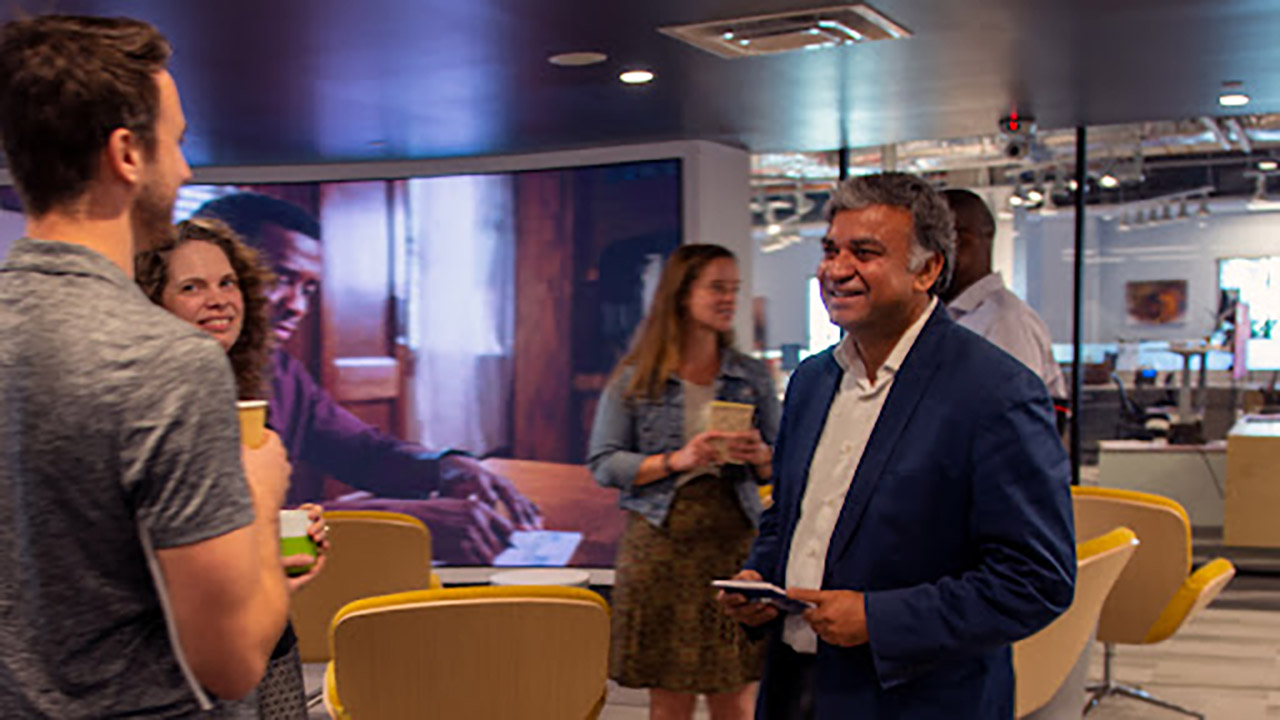
Incoming VPR Shashank Priya greets Tech Comm staff during a September 1st visit.
On September 30, 2022, Shashank Priya will assume the role of vice president for research at the University of Minnesota, bringing a wealth of experience as a scholar, researcher, and administrator as well as enthusiasm for UMN research and discovery.
“I am very excited about joining this highly talented and experienced team that is engaged in managing a billion-dollar research enterprise with huge social, environmental, economic, and security impact,” Priya said. “There is profound depth and breadth of research expertise across our campuses that makes it possible to conceive and implement high-impact interdisciplinary programs.”
Priya comes to the University from Pennsylvania State University, where he has served as associate vice president for research and managed several strategic responsibilities of the research office. Of his accomplishments in this role, he is especially proud of growing Penn State’s Strategic Interdisciplinary Research Office (SIRO), which handled the submission of large and complex proposals, and managing the Commonwealth Campus Research Programs, which helped faculty initiate and conduct competitive research. He reorganized SIRO and doubled its size, which led to an increased number of proposal submissions with high funding rates. He seeded research activities across Penn State’s multiple campuses in the form of small grants to work with core facilities and large grants to form center nodes. He also grew international research partnerships with universities in Europe, Australia, and Asia and worked with university-wide core facilities to develop plans for equipment needs. As part of his strategic initiatives portfolio, he organized faculty teams on developing new ideas and worked with them on securing funding.
As vice president for research at the University, Priya will oversee a $1+ billion research enterprise across all campuses and have responsibility for units that administer sponsored projects, research and regulatory compliance, and technology commercialization, as well as for 10 interdisciplinary academic centers and institutes and a growing corporate engagement portfolio for the University.
“The University’s talent, culture, location, diversity, inclusion, and infrastructure provide a great foundation for addressing current and emerging social, environmental, and economic challenges,” Priya said. He recognizes the University’s history of scholarship across all disciplines, which encompasses an appreciation for all forms of creativity and scholarship, including the arts, and appreciates the University’s land grant legacy of serving the needs of the community. He also appreciates the University’s well-oiled approach to the full-cycle of innovation, from basic science to technology development to translation.
“Building upon this strong foundation, I look forward to working with researchers in conceiving and growing programs that will have significant national and global impact. I feel we are well-positioned to design and lead transformative programs that leverage these collective strengths,” Priya said, adding that his initial goals as VPR can be divided into two categories: operational and programmatic.
Operationally, he hopes to continue to strengthen and grow the University’s research infrastructure and engineer organizational structures that enhance process efficiency by leveraging modernization of technology and facilities. He will also seek ways to reduce faculty administrative burden while still ensuring the highest levels of safety and compliance with regulatory practices. He will partner with colleges and campuses to address the emerging needs of the research community and increase the probability for gaining external funding.
Programmatically, Priya wants to create new initiatives in partnership with the corporate community, government agencies, and UMN alumni, to expand funding opportunities and the ability to move innovation born of research into the marketplace. He envisions the creation of new institutes, centers, and consortiums that respond to national grand challenges while also paving the pathway for future technologies with transformative societal implications. He plans to spend a significant amount of time during his early months at the University listening to and learning more from faculty members, academic leaders, center and institute directors, and research staff, and co-developing initiatives that benefit the research community within and beyond the University.
“I will be meeting our researchers and staff to learn, brainstorm ideas, and jointly develop strategies that advance our research and educational mission. This is teamwork, and we all have important tasks to accomplish. Everything counts when we are performing at the highest levels.”
In contemplating his move to the Twin Cities, Priya is excited to live in an urban setting after spending most of his career in smaller university towns. Priya and his wife, Ai, both grew up in towns around water – River Gomti in India and Lake Biwa in Japan – and the pair are looking forward to living near water again. Outside of work, Priya enjoys hiking with his Great Dane, Marble, playing badminton with his daughters, and following international cricket and college football.